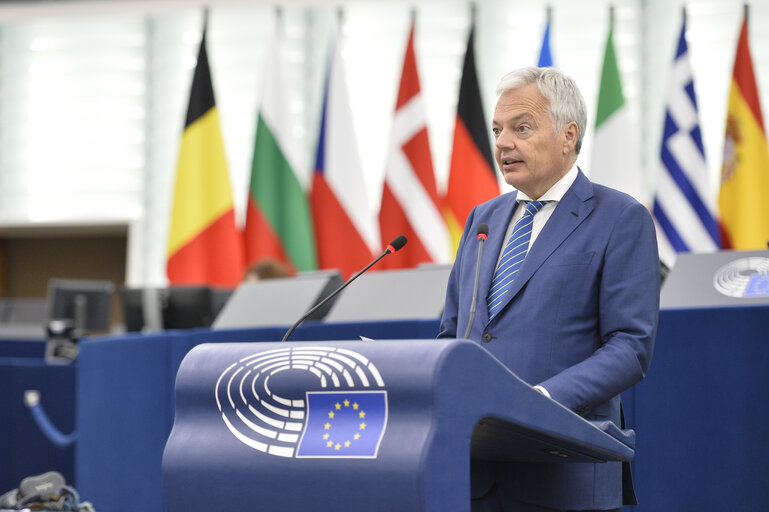Yesterday, the European Parliament discussed the role of cities and regions and the potential for regional development within the EU. The debate attracted relatively little interest, as many representatives were either absent or not engaged in the topic. Yet, this was one of the most critical discussions to shape the next cycle fundamentally. Primarily, Spanish representatives were active, focusing on three main elements.
Author: Szilárd Szélpál
The first, and for us, the most crucial element, was that Commission President Von der Leyen had previously outlined a program during a plenary session that would define the five-year cycle, including points that might challenge the existing foundations of regionalism. What does this mean in practice? The centralization of Cohesion Funds. In more detail, this program shifts the allocation of the Cohesion Fund, which represents a third of the EU budget, to a centralized decision-making process, handing control over to the Commission and the governments of member states. This would be done so that the interests of regions and major cities would be disregarded and their advisory opinions not sought. This step seems understandable from Von der Leyen’s perspective, as the EU is currently grappling with competitiveness challenges in key sectors like steel production and the automotive industry. In recent years, Chinese industrial dumping, particularly affecting the automotive industry and related sectors, alongside the economic aftermath of the COVID crisis, has presented unprecedented challenges for national governments and the EU. Unfortunately, the search for solutions has taken a misguided direction, failing to focus on the essentials—a topic to be discussed later.

The second element was the retention of the principle of subsidiarity and a much broader inclusion of regional actors in the allocation of funds. From the representatives’ standpoint, this is a logical and reasonable step, as local communities are the ones who best understand their local needs and the areas that require investment or quality services for their residents.
The third element focused on climate goals and carbon emission reduction. Everyone agreed that cities and regions bear the brunt of meeting these emission targets. This is a real problem, as member states impose these quotas on local communities, requiring them to measure and meet the emission limits. Beyond the three main elements, representatives also touched on housing issues, migration, and depopulation. But no one addressed the core issue! What is that?
The program, set to overhaul the Cohesion Fund’s allocation mechanism, will fundamentally shape the EU’s development and the evolution of its legal framework. My mind goes back to my previous PhD topic: Urban Philosophy. In Hungary, no one had previously examined the city as an entity in a philosophical sense, focusing instead solely on the role and significance of the state or the individual. International examples exist where others have evaluated cities from a historical perspective, like Oswald Spengler. In contrast to his theory, which sees their development ending in complete decline, my view is quite different. It focuses on what should have arisen in every participant’s mind during this debate—the sharp contrast between the role and perception of regionalism and the traditional state. The Commission’s proposal for centralization aligns with the importance and sovereignty of member states, while the representatives sided with regionalism. Why is this important to discuss? Because under the current framework, the EU has reached its developmental peak. From here, there are only two paths: slow erosion, advocated by extremist, anti-EU parties and factions—mostly aligned with Russian interests—or institutional reform, leading to a federal Europe in second gear.

Why do I think this? The Cohesion Fund, which makes up a third of Europe’s budget, is exclusively intended to support regions and municipalities, helping lagging regions catch up with economically more robust, industrialized areas. Yet, it is the member states that redistribute locally generated resources, directly or indirectly hindering the natural development of certain cities or municipalities. Hungary is a perfect example of this, where the government has legally withdrawn revenue sources from municipalities, integrating a significant portion of locally collected taxes into the central budget, from where they are redistributed in a highly subjective manner—often based on political affiliation or corruption. Solving this issue is not simple. If we aim to strengthen the role of cities and regions, institutional reform should involve granting the Commission the direct authority to allocate and disburse funds. Cities and regions should be able to apply to the Commission for resources directly, bypassing national leadership. At the same time, cities and regions should be given more rights at the national level. History has proven that only those municipalities that enjoyed additional rights—be they royal privileges, commercial rights, etc.—could excel, prosper, and grow. These are the rights that today’s cities and regions lack. Suppose we acknowledge that we want to maintain local communities’ retention capacity, capital attraction ability, and competitiveness. In that case, we need to move towards decentralized governance at the national level while pursuing centralized, federal governance at the EU level regarding legislation and resource allocation.
Several participants cited that 70-75% of the EU’s population currently lives in urban or metropolitan environments. This foreshadows inevitable rural depopulation. Rural areas are losing population because there are not enough resources and adequate investments at the local level to retain residents. Accelerating digitalization may offer a temporary solution by increasing the role of home offices. However, this is only viable in sectors where most work is conducted online. Another solution could be self-sufficiency, which is legally restricted in all member states. Governments do not want to relinquish control over large state distribution companies, as taxes and revenues from their services constitute a significant portion of national budgets—particularly in critical infrastructure sectors like energy supply and water systems. If rural residents were given the opportunity for energy self-sufficiency, which is now possible with affordable renewable energy technology, it would not only ease their livelihoods but also lead to significant savings. This opportunity could also provide a solution for cities. If they become energy self-sufficient, they can reallocate considerable resources, as they would not have to pay into the central budget through a state company. Renewable energy-based energy self-sufficiency allows member states to use their existing energy capacities and distribution networks—freed up due to self-sufficient cities and regions—to support energy-intensive industries. This produces cheaper energy for industrial players, thanks to the state’s excess capacities. If the EU complements this with a unified carbon tax within the internal common market, it would also allow for fair competition with cheap Asian imports. Naturally, this also implies reducing the role and significance of states and government decision-making powers. Given the recent surge of extremist populist parties and their election results, this may not necessarily be a problem.
Beyond the proposed solutions, it is worth considering the direction of future development. According to research, 90% of humanity will live in urban environments in the coming decades. This will result in the creation of megacities. These mega-cities will concentrate political and economic power to such an extent that the significance of the state in which they are located will diminish or, in some cases, disappear entirely. We have already seen examples of this in the cases of London, Paris, the Benelux Triangle, and the Northern Italian Turin-Milan line. These areas will become so densely populated that the city-state concept can be redefined, not in the miniature sense we associate with the Vatican.
Decision-makers must prepare very seriously for the above-outlined problems and the solutions required. Much more seriously than yesterday’s plenary session demonstrated. This will fundamentally determine the entire institutional structure of the EU, its powers, and the levels of subsidiarity. These debates cannot be exploited solely for party propaganda; instead, everyone should deeply consider the direction Europe should take. A loose, sovereign community or a federal entity..?
Cover photo credit: https://multimedia.europarl.europa.eu

Szilárd Szélpál served as an environmental expert in the European Parliament from 2014, where he utilized his expertise to influence policy-making and promote sustainable practices across Europe. In addition to his environmental work, Szilárd has a deep understanding of foreign affairs, offering strategic advice and contributing to the development of policy initiatives in this field.



